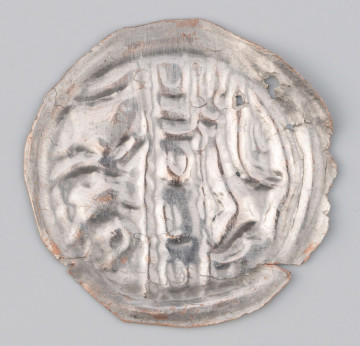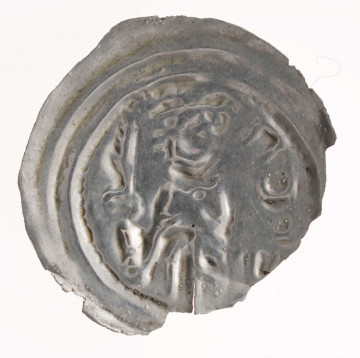
Bracteate of Mieszko III the Old
1181 — 1202
National Museum in Lublin
Part of the collection: Money on Polish territory in the Middle Ages
After Władysław (1138-1146), the senior of the dynasty, was deposed from the throne, Bolesław the Curly (1146-1173) became the supreme prince of the Polish quarter. His sovereign power included the exclusive right to issue money, which in addition to its economic function conveyed propaganda messages. At the same time, the minting of coins brought significant income to the princely treasury, which was achieved through the cyclical exchange of coins according to a conversion advantageous to the issuer (for example, three old denarii for two new ones). It guaranteed a profit of several dozen percent. New issues were distinguished by different, easily distinguishable images. The exchange of money was a form of tax imposed on subjects. However, its frequent use increased social discontent, which could turn into a rebellion threatening the authorities. This prompted Bolesław the Curly to abandon the fiscal policy of his predecessor and significantly reduce the frequency of the exchange of denarii. Therefore, during the twenty-seven years of his reign, he minted only four basic types of coins, related to the exchange. The treasury administration of the time was not efficient enough to carry out a complete exchange of money, and some older issues functioned in parallel with the newly introduced ones.
The bust of the prince with a sword pointing upwards depicted on the obverse of the discussed denarius, dating from around 1164 to around 1170, expressed the ability of the ruler to defend the state and the Church against physical and spiritual enemies. It indicated his judicial supremacy and just rule. Among the three brothers behind the table shown on the reverse, the figure seated in the middle should be identified with Bolesław, the senior, who was certainly accompanied by his brother Mieszko (born between 1122 and 1125). The third figure may have been Henryk Sandomierski († 1166) or the youngest of the brothers, Casimir the Just (born 1138). If it was Casimir the Just, the coinage would have been issued after the death of Henryk Sandomierski. The depiction of the prince-in-chief in the company of his brothers was intended to show a harmonious cooperation in the Piast dynasty, free from the conflicts with which the previous reign had been saturated.
The denars of Prince Bolesław remained in use for several decades.
Tomasz Markiewicz
Author / creator
Dimensions
cały obiekt: diameter: 18,5 mm
Object type
numismatic
Technique
stamp minting
Material
silver
Creation time / dating
Creation / finding place
Owner
The National Museum in Lublin
Identification number
Location / status

1181 — 1202
National Museum in Lublin

1180 — 1199
National Museum in Lublin

1181 — 1202
National Museum in Lublin
DISCOVER this TOPIC
Museum of King Jan III's Palace at Wilanów
DISCOVER this PATH
Educational path